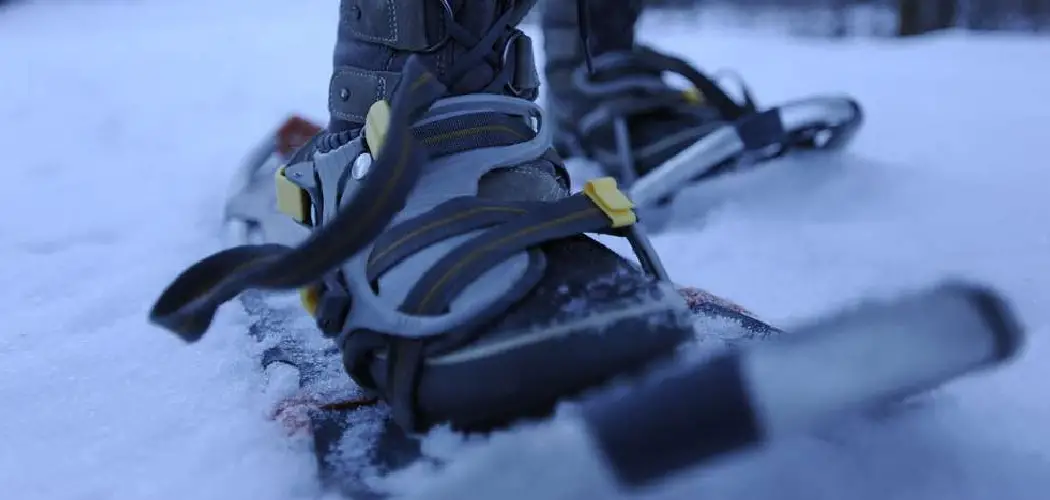Are you planning to go out in the snow and explore nature? If yes, then you must have considered using snowshoes. Snowshoes are a great way to trek through snowy landscapes and make your journey more enjoyable and comfortable.
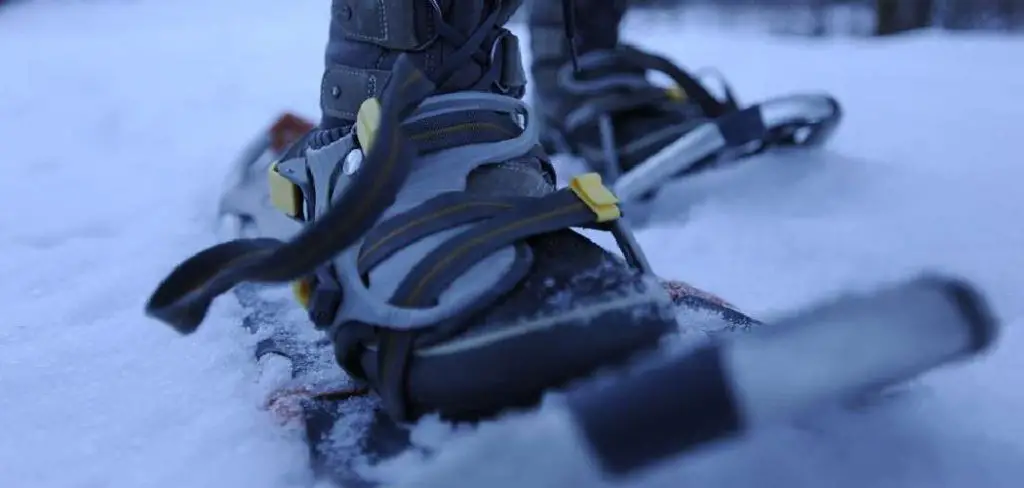
How to use snowshoes is an enjoyable and accessible winter activity that allows individuals to easily traverse snowy landscapes. Unlike traditional winter sports that may require specialized skills, snowshoeing is beginner-friendly and provides a unique way to explore nature during the colder months.
This guide is designed to introduce you to the world of snowshoeing, covering the basics of selecting the right snowshoes, understanding how to walk in them, and preparing for a venture into the snow-covered wilderness. Whether you’re looking to stay active during the winter or simply want to enjoy the serene beauty of a snowy landscape, snowshoeing offers a perfect opportunity to do so.
What are the Benefits of Snowshoeing?
Snowshoeing is not only a fun outdoor activity, but it also offers numerous physical and mental health benefits. Here are some of the key advantages of snowshoeing:
- Low Impact Exercise: Unlike running or other high-intensity winter sports, snowshoeing is low impact, making it an ideal activity for people with joint issues or those who want to avoid high impact activities.
- Accessible for All Ages and Fitness Levels: Snowshoeing doesn’t require any special skills, making it accessible for people of all ages and fitness levels. Whether you’re a beginner or an experienced hiker, you can enjoy snowshoeing at your own pace.
- Full Body Workout: Walking in the snow with snowshoes engages various muscles in your body, including your legs, core, and arms. It’s an excellent way to get a full-body workout while enjoying the winter outdoors.
- Opportunity for Socializing: Snowshoeing is a great way to spend quality time with friends or family. You can make it a group activity and enjoy each other’s company while exploring the snowy landscape.
- Mental Health Benefits: Spending time in nature has been linked to improved mental health and well-being. Snowshoeing offers a perfect opportunity to disconnect from the stress of daily life and connect with nature, leading to reduced anxiety and depression levels.
These are just some of the many benefits that snowshoeing offers. So, if you’re looking for a new winter activity that is fun and beneficial for your health, try snowshoeing.
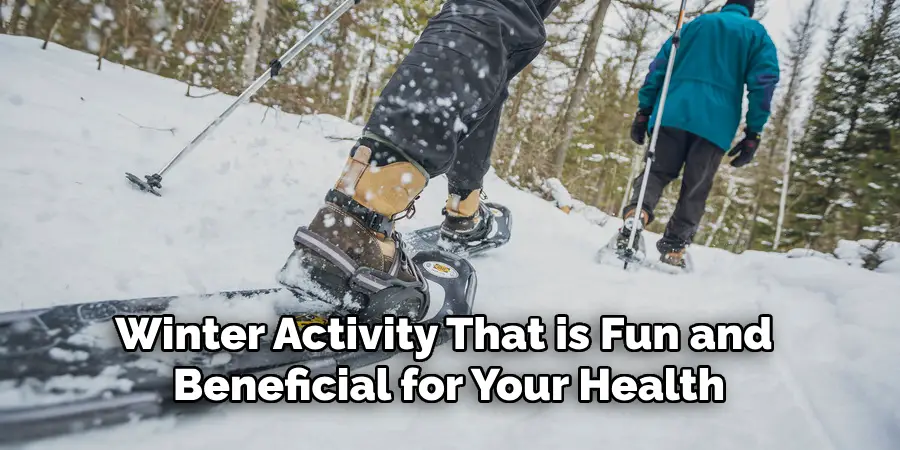
What Will You Need?
Before you embark on your snowshoeing adventure, you must gather a few essential items. Here’s a list of what you should bring with you:
- Snowshoes: Of course, the first and most important item for any snowshoeing trip is the snowshoes themselves. Make sure to choose the right size and type of snowshoes based on your weight and the type of terrain you’ll be exploring.
- Hiking Boots: While specialized snowshoeing boots are available, you can also use sturdy hiking boots that provide ankle support and have good traction.
- Layers of Clothing: Dressing in layers is crucial for staying comfortable during your snowshoeing trip. Start with a moisture-wicking base layer, add a warm mid-layer, and top it off with a waterproof and windproof outer layer.
- Trekking Poles: Trekking poles can provide extra stability and support while walking in snowshoes, especially on uneven terrain. They also help to reduce the impact on your joints.
- Water and Snacks: Just like any outdoor activity, staying hydrated and energized while snowshoeing is important. Pack plenty of water and snacks to keep you going throughout the trip.
- Map and Compass: While many modern snowshoes come with built-in navigation tools, it’s always a good idea to have a map and compass with you as a backup in case of technical difficulties.
Make sure to pack all these items in a backpack that is comfortable and easy to carry. Now, you’re ready to hit the snow-covered trails!
10 Easy Steps on How to Use Snowshoes
Step 1. Choose the Right Snowshoes:
Selecting the appropriate snowshoes for your adventure is crucial. The key factors to consider include your weight, the type of terrain you’ll be venturing into, and the snow conditions. Generally, the heavier the person or the softer the snow, the larger the snowshoe needed to properly distribute weight and prevent sinking. There are three main types:
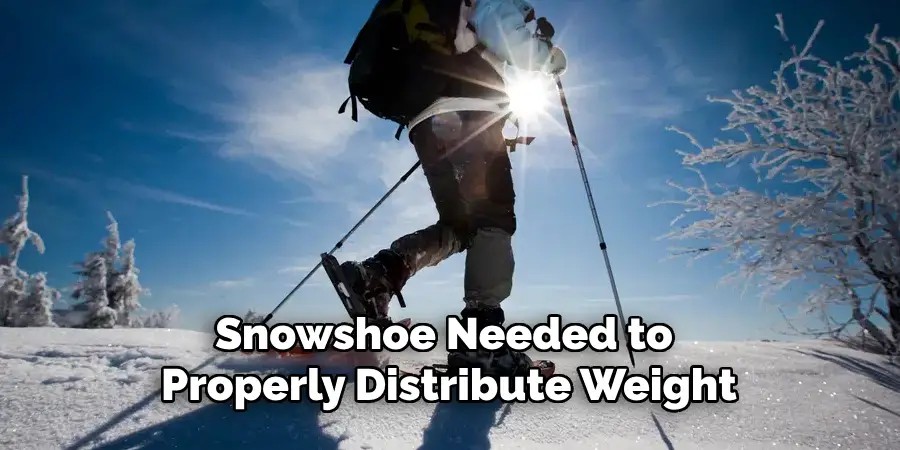
- Flat Terrain Snowshoes: These snowshoes are ideal for beginners or those planning to walk on well-groomed trails. They have easy-to-adjust bindings and a flat design that makes walking straightforward.
- Rolling Terrain Snowshoes: These are designed for hikers and adventurers who plan to traverse hills and varied terrain that aren’t steep enough to require mountaineering skills. They come with more aggressive crampons for grip and sturdier bindings.
- Mountain Terrain Snowshoes: These snowshoes are best for advanced users who will be climbing steep, icy, or off-trail terrain. They feature strong bindings and aggressive crampons for maximum traction.
When choosing snowshoes, also consider their ease of use, especially the binding system, to ensure you can quickly adjust them while wearing gloves. Furthermore, pay attention to optional features like heel lifts, which make uphill climbs more comfortable by reducing calf strain.
Step 2. Wear the Right Shoes:
Before stepping into your snowshoes, ensuring you’re wearing the right footwear is important. Waterproof hiking boots are a great choice as they provide the necessary support and warmth. Ensure your boots are well-insulated and comfortable, with enough room for thick socks without restricting circulation. Proper footwear protects your feet from the cold and enhances your overall snowshoeing experience by preventing blisters and maintaining comfort throughout your adventure.
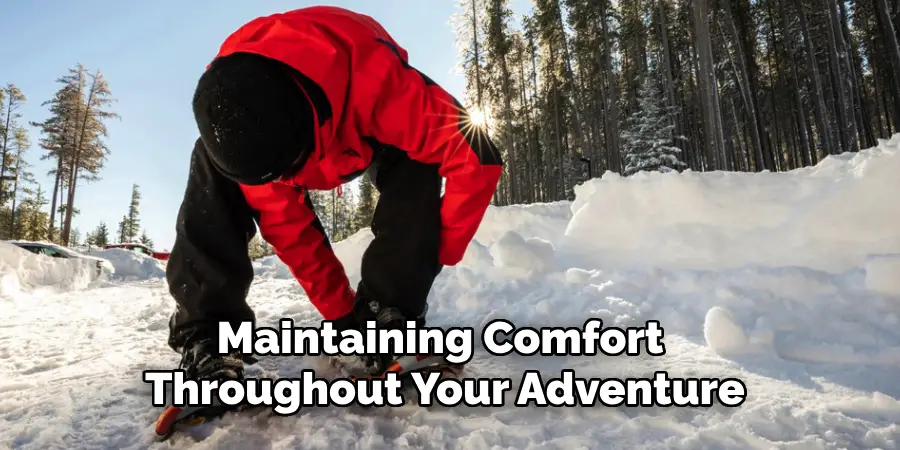
Step 3. Dress Appropriately:
Equally crucial as selecting the right snowshoes is dressing suitably for your snowshoeing outing. The key is to layer your clothing to manage body temperature effectively during your activity. Start with a moisture-wicking base layer to keep sweat away from your skin, followed by an insulating layer to retain body heat, and finish with a waterproof and windproof shell layer to protect against the elements.
Avoid cotton as it retains moisture, potentially leading to hypothermia in cold weather conditions. Also, remember to protect your head, hands, and feet with waterproof gloves, thermal socks, and a warm hat. Layering allows you to add or remove clothing based on your activity level and changes in the weather, ensuring you stay comfortable throughout your snowshoeing adventure.
Step 4. Adjust Your Snowshoes Properly:
Before you head out, you must ensure that your snowshoes are adjusted correctly to fit your boots. Start by placing your boot squarely on the snowshoe, with the ball of your foot aligned with the pivot point.
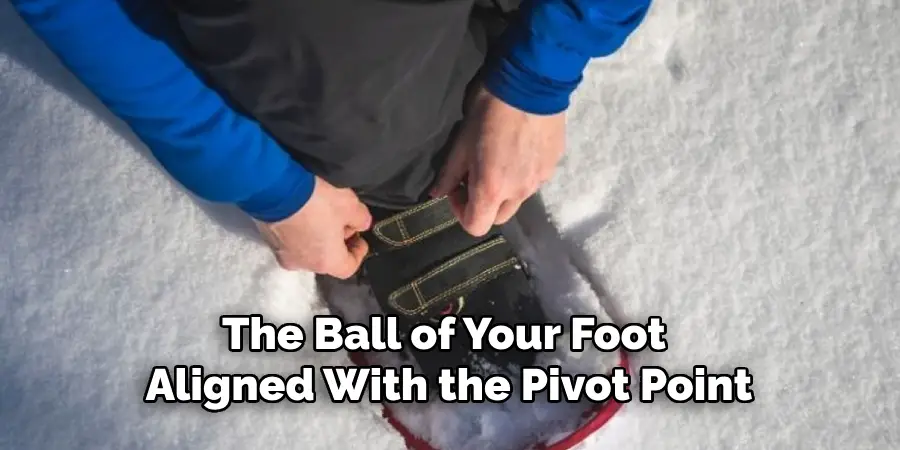
Then, tighten the straps or bindings starting from the front and moving to the back, ensuring a snug fit without overtightening. Your toes should not hang over the front edge, and your heel should be centered on the deck. Proper adjustment is key to maintaining comfort and ensuring efficient movement while minimizing the risk of tripping or losing a snowshoe during your trek.
Step 5. Practice Walking in Snowshoes:
Before venturing out into deeper snow, take some time to practice walking in your snowshoes on a flat surface. Snowshoes alter your natural gait, so getting used to the wider stance required to accommodate their size is important. Begin by lifting your feet slightly higher than you would normally, and step forward, planting the entire snowshoe on the ground with each step.
Avoid stepping on the sides of your snowshoes with your other foot, as this can cause you to trip. Practice turning around, walking backward, and using your trekking poles for balance. Once you feel comfortable with the basics of walking in snowshoes, you’ll be ready to tackle more challenging terrain with confidence.
Step 6. Learn How to Ascend and Descend:
Ascending and descending on snow-covered slopes requires specific techniques for safety and efficiency. When ascending a hill, using the toe or instep crampons for grip is helpful. If your snowshoes have heel lifts, raise them to ease calf strain on steep inclines. Take small steps and lean forward slightly to maintain balance. For descending, lean back slightly and place your weight on your heels to engage the snowshoe’s rear crampons for better traction.
Use your trekking poles for additional support, adjusting their length if necessary to suit the slope you’re navigating. Practicing these techniques will help you move confidently and safely in varied snowshoeing terrain.
Step 7. Mastering Turns:
Turning while wearing snowshoes is a skill that improves with practice and is essential for maneuvering through winding trails and narrow spaces. To execute a simple turn, plant your poles beside you for stability and step around in the direction you want to go, moving one foot at a time.
For sharper turns, the kick-turn is effective—lift one foot and place it down in the new direction, then follow with the other foot, forming a kickstand position momentarily before completing the turn. Practicing in a safe, open area can help you become more comfortable with turns, easing your way through more complex trail systems.
Step 8. Navigating Through Deep Snow:
Navigating through deep snow requires more effort and energy than traversing on packed snow. When faced with deep snow, it’s important to use a “stamping” or “packing” technique to create a solid path. Start by lifting your knees higher and pressing down firmly with each step to compact the snow beneath you, which will make it easier to follow steps and reduce the chances of post-holing (sinking deeply into the snow).
If you’re snowshoeing in a group, take turns leading, as the person in front will exert more energy packing the snow for those that follow. Keep your pace steady and adjust your route as necessary to manage your energy effectively throughout your adventure.
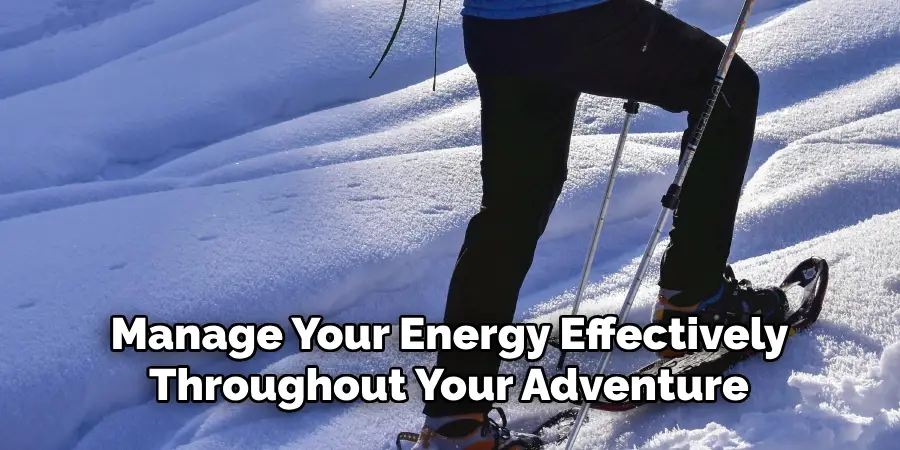
Step 9. Stay Hydrated and Energized:
Maintaining hydration and energy levels is vital during your snowshoeing adventure, especially in cold environments where you might not feel as thirsty. Carrying a water bottle or a hydration bladder with warm fluids can prevent your water supply from freezing and encourage regular sips to stay hydrated.
Pack high-energy snacks like nuts, energy bars, or dried fruit that can be easily consumed on the trail. Eating small, frequent snacks can help maintain your energy levels, ensuring you have enough stamina to enjoy your snowshoeing experience to the fullest. Remember to adjust your backpack straps to comfortably carry your supplies without affecting your balance or mobility.
Step 10. Be Prepared for Emergencies:
It’s essential to be prepared for any emergencies that might arise during your snowshoeing adventure. Carry a basic first aid kit with bandages, antiseptic wipes, blister pads, and any personal medication. Be sure to have a fully charged mobile phone in a waterproof case and, if possible, a portable charger.
Knowing the signs of hypothermia and frostbite and how to respond can be lifesaving. Additionally, inform someone of your planned route and expected return time before you depart. Being prepared means focusing on enjoying the beauty and thrill of snowshoeing while staying safe.
By following these steps, you will be well on your way to becoming a snowshoeing pro. Remember to always check the weather and snow conditions before heading out, wear appropriate layers of clothing, and bring necessary equipment such as a map and compass.
5 Additional Tips and Tricks
- Adjust Your Stride: It’s essential to modify your walking style when using snowshoes. Your stride will naturally be wider to accommodate the size of the snowshoes. Taking shorter, more deliberate steps can help prevent the shoes from overlapping and causing a fall.
- Use Poles for Balance: Trekking poles with snow baskets are invaluable tools for maintaining balance and rhythm on varied terrain. They can significantly enhance stability, especially on steeper inclines or uneven ground covered by deep snow.
- Dress in Layers: Weather conditions can change rapidly in winter environments. Wearing moisture-wicking base layers, insulating mid-layers, and waterproof outer layers allows you to adapt to shifting temperatures and maintain comfort throughout your snowshoeing adventure.
- Understand the Terrain and Snow Conditions: Different snow conditions and terrains can drastically affect the difficulty of your trek. Fresh powder is more challenging to move through than packed snow and flat terrain is significantly easier to navigate than steep slopes. Tailor your route and equipment choices to these variables for a safer and more enjoyable experience.
- Practice Putting On and Taking Off Your Snowshoes: Before hitting the trails, familiarize yourself with properly attaching and removing your snowshoes. This knowledge can save valuable time and reduce frustration during your outings, especially when dealing with cold fingers or deep snow.
With these additional tips and tricks, you can enhance your snowshoeing experience and make the most out of your winter adventures.
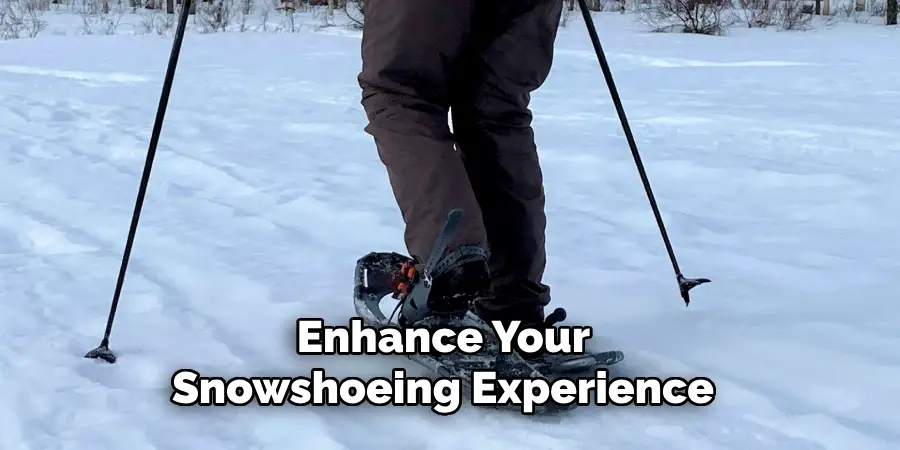
5 Things You Should Avoid
- Ignoring Weather and Avalanche Reports: Venturing into the backcountry without checking current weather conditions and avalanche risk can be dangerous. Always prioritize safety by being informed of the day’s forecast and potential avalanche warnings.
- Wearing Improper Footwear: Using regular shoes or boots not designed for cold, snowy conditions can result in cold, wet feet, potentially leading to frostbite. Ensure you wear waterproof boots that provide warmth and support for snowshoeing.
- Neglecting to Hydrate: Just because it’s cold doesn’t mean you don’t sweat or need less water. Dehydration in cold weather is just as likely as in warmer climates, potentially leading to impaired judgment and fatigue. Always carry and consume sufficient water.
- Forgetting to Apply Sunscreen: The sun’s reflection off the snow significantly increases UV exposure, putting you at risk for sunburn. Apply a high-SPF sunscreen to exposed skin, even on cloudy days, to protect against sunburn.
- Snowshoeing Alone in Remote Areas: While snowshoeing can be a serene experience, doing it alone in isolated areas increases risk. If you get lost or injured, help may not be readily available. Always inform someone of your route or, better yet, bring a companion.
By avoiding these common mistakes, you can ensure a safe and enjoyable snowshoeing adventure.
Is Snowshoeing Better Than Walking?
The answer to this question is subjective and depends on personal preferences. Snowshoeing offers a unique experience by allowing you to trek through deep snow and explore winter landscapes that may be inaccessible on foot. It also provides a great form of cardiovascular exercise and can be an enjoyable group activity.
However, walking has its own benefits, such as covering longer distances at a faster pace, being more accessible, and not requiring any special equipment. It may also be more suitable for those with physical limitations.
Ultimately, whichever activity brings you the most joy and suits your fitness level and goals is the best option. Whether it’s snowshoeing or walking, getting outside and staying active is always beneficial for both physical and mental well-being.
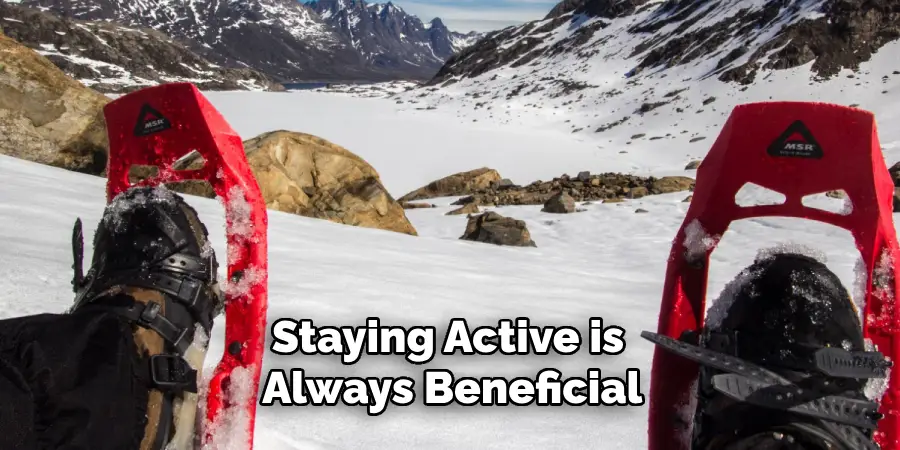
Conclusion
In conclusion, how to use snowshoes opens up a new realm of winter exploration and enjoyment, allowing adventurers to traverse snowy landscapes with ease and confidence. By adjusting your stride, utilizing poles for balance, dressing in layers suitable for changing conditions, understanding the terrain and snow conditions, and practicing applying and removing your snowshoes, you can significantly enhance your snowshoeing experience.
Conversely, avoiding common pitfalls such as neglecting weather and avalanche reports, wearing improper footwear, failing to hydrate, forgetting sunscreen, and snowshoeing alone in remote areas is crucial. Whether you choose snowshoeing for the rigorous workout it provides, the tranquility of snow-covered surroundings, or the joy of exploring inaccessible winter terrains, it offers a unique and rewarding outdoor activity.
Remember, the essence of snowshoeing lies in the freedom it offers to enjoy nature’s winter marvels safely and comfortably.

